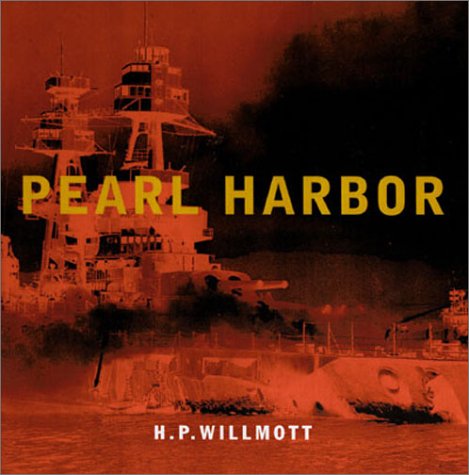


In selecting any book concerning Pearl Harbor, one must consider this pivotal event not only on the basis of consequences but also on the basis of origins. In H. P.Willmott's Pearl Harbor not only is the actual attack itself examined but the historical and political events leading to war in the Pacific between the United States and Japan are summarized thoughtfully and concisely.
In typical Willmott fashion, he begins by acquainting the reader with the turbulence of the times which found Japan and the United States increasingly at odds both economically and politically. Overwhelming victories over China in 1895 and Russia in 1905 earned Japan a position of preeminence in the western Pacific of which she took ample advantage during and following the First World War. Japan's subsequent war with China, which began in September 1931, progressively widened the rift between Japan and the Western powers, primarily the United States. Yet, as Willmott points out, this increasing flirtation with war only brought Japan closer to the abyss of domestic economic ruin. And despite an obvious inability to simultaneously wage war against China and support a domestic economy, Japan could not turn away from a course aligned with Germany and Italy. By September 1940, Japan's militarist leadership ratified the Tripartite Pact, tying herself to the fortunes of European dictatorships.
By discussing how she established and provided for her navy – the Kaigun – Willmott reveals how Japan vaulted from defenceless kingdom to major seapower within but a few generations. But economic realities following the First World War brought the three major naval powers – the United States, Great Britain and Japan – to the table of arms treaties. Ironically, this effort provoked a polarizing debate within Japan's navy and accelerated the march to war. As Japan drifted to war she proposed to fight a decisive fleet battle against the United States in the western Pacific which, in turn, drove tactical thought and ship design. Yet the Japanese never managed more than a vague conception of how they would conduct a war against an economic powerhouse such as the United States. As one reads Willmott, it is difficult to escape the impression that the Japanese had little more than an amateurs' view of the economic realities of modern war.
Against this backdrop, Willmott analyzes the origins, planning, and attack against Pearl Harbor. While this has been ably discussed by many authors, Willmott presents a brief but detailed overview of each issue. The proposed attack represented a radical departure of strategy and was considered by many Japanese to be a major mistake. The intrigue of the Combined Fleet staff in pushing their plans for the attack against Pearl Harbor is discussed in more than the usual detail. A similar manner of intrigue would later propel the Midway Operation in mid-1942, with tragic results for the Kaigun. Willmott examines the supposed connection between the British attack on Taranto in November 1940 and the Japanese planning for Pearl Harbor. He also addresses the many hurdles which the Japanese had to overcome to place their Striking Force across the Pacific and within range of Hawaii. Finally, Willmott discusses the 'day of infamy' in concise terms.
The real treat in this book, and one which distinguishes it from others, is the attention devoted to possible followup strikes by the Japanese against Pearl Harbor and surrounding facilities. In dispelling numerous comments by observers from Morison to Nimitz, Willmott dissects the various considerations surrounding further air strikes. By devising a timeline and an assessment of aircraft available after the first two waves, Willmott persuasively demonstrates that there was neither the time nor the resources to mount further attacks against Oahu after the second wave returned to their carriers.
Willmott's book is divided into 6 chapters, a foreword, two afterwords, several appendices and is printed on heavy, acid free stock. It weighs in at 210 pages but is neither a difficult nor a long read. Supported by numerous maps, drawings and tables, it is profusely illustrated with clear but familiar photographs, many of which are reproduced in color. This photography is supplemented by numerous reproductions of contemporary paintings and periodical covers. All in all, this book is well organized and produced.
There are many annoying errors within the text and the captioning, something shared by another of Willmott's recent Cassell publications, but these errors are minor compared with the overall content and are easily recognized by any who possess familiarity with the topic. Perhaps most surprising of all, however, Willmott presents a case for one of the attacking midget submarines torpedoing the battleships during the raid. It is difficult to understand how this could be true and represents one of the few major errors Willmott makes in any of his writings. But the most glaring weakness of all in this book is the complete lack of a bibliography. There is simply no reason for not providing one, particularly when the authors' research rests so heavily upon secondary sources.
I strongly recommend this book. It easily holds its own with, and supplements, other fine books concerning the attack on Pearl Harbor, including Prange's At Dawn We Slept, Lord's Day of Infamy, and Wallin's Pearl Harbor: Why, How, Fleet Salvage and Final Appraisal. It is an excellent book and deserves a place in any library devoted to the Pacific War.

